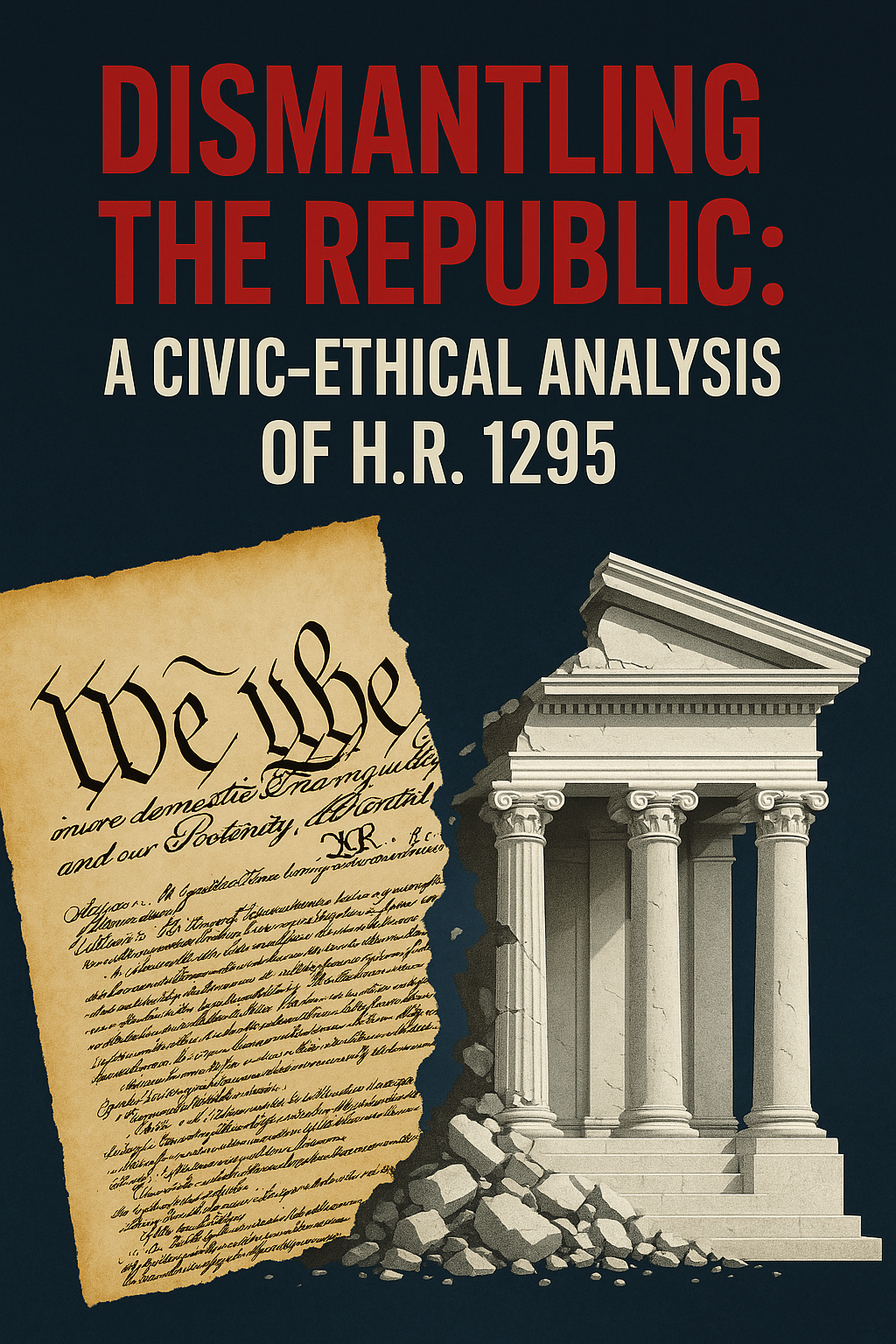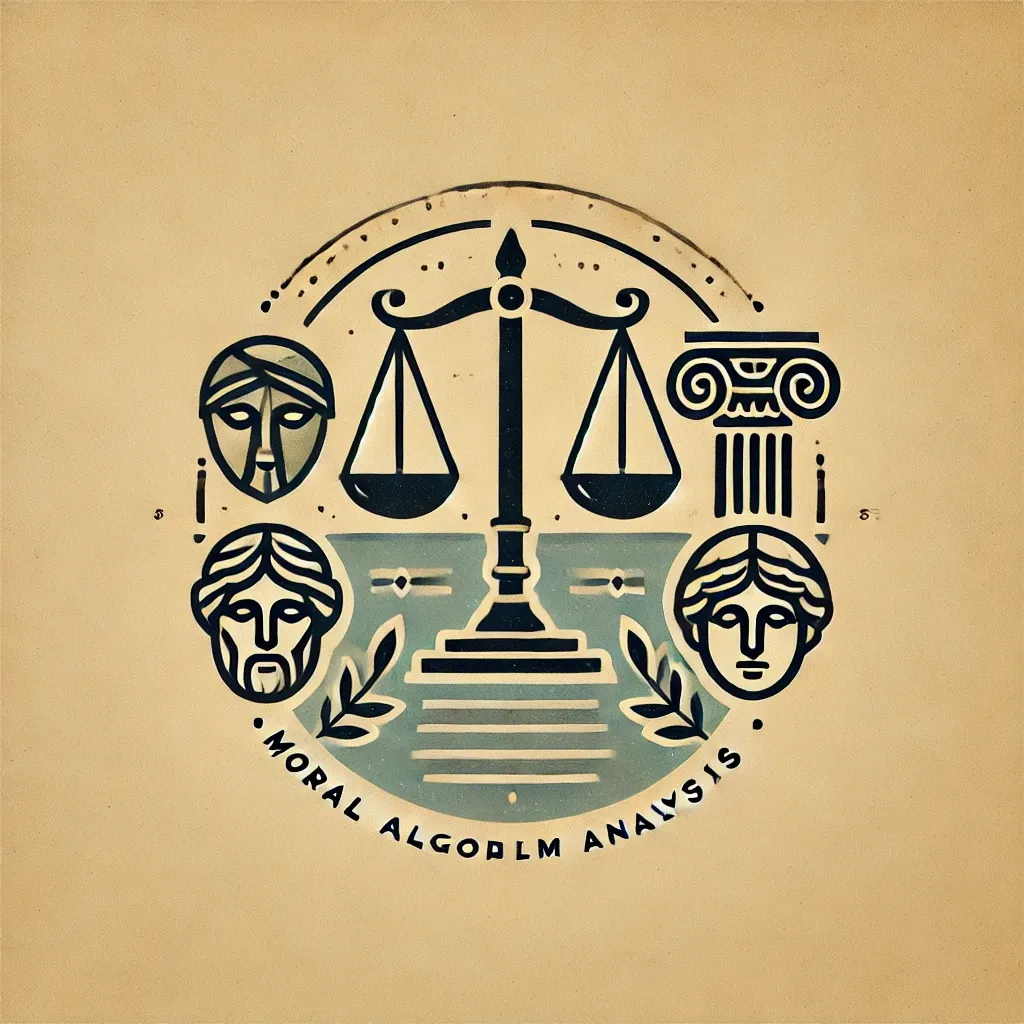Dismantling the Republic for Corporate-Authoritarianism
H.R. 1295 empowers the President to dismantle federal agencies and programs, undermining public institutions and checks on power. This analysis questions its ethical, civic, and economic impact, asking: What kind of society does this produce?

A Civic-Ethical Analysis of H.R. 1295
What kind of society does this produce?
H.R. 1295, the "Dismantling Government Act," represents one of the most sweeping proposals for executive power expansion and federal program elimination in modern U.S. history. At its core, the bill would empower the President to unilaterally:
- Abolish federal agencies (e.g., Department of Education, CFPB)
- Eliminate statutory programs such as Social Security, Medicare, and Medicaid
- Reorganize government functions without congressional checks
- Nullify regulations deemed burdensome
- Mass fire federal workers with reduced judicial oversight
Reviving executive reorganization authority unseen since 1984, H.R. 1295 goes further than any prior precedent. It centralizes control, dismantles institutional safeguards, and prioritizes concentrated executive discretion over constitutional balance.
Systemic Consequences
Centralization and Fragility
The bill collapses the separation of powers by granting the President authority to reshape government without traditional legislative deliberation. Regulatory agencies—many of which safeguard public goods—are targets for elimination, which directly undermines Elinor Ostrom's principles of commons governance.
Inequality by Design
Stripping public programs and shrinking government employment redistributes power and resources upward. This reflects the Cantillon Effect: those closest to money creation and policy influence benefit first, while the broader public absorbs the cost.
Contradictions and Ironies
A platform claiming to defend constitutional liberty paradoxically promotes executive overreach. A movement touting individual freedom seeks to erase collective safeguards that protect the vulnerable. These contradictions suggest an ideology more aligned with oligarchy than civic republicanism.
Ethical and Civic Reasoning
John Adams' Moral Algorithm
"Government is instituted for the common good... not for the profit, honor, or private interest of any one man, family, or class of men."
H.R. 1295 fails this standard. It dismantles public institutions in service of concentrated power, not the common good. Programs that serve the elderly, disabled, and working class are discarded in favor of private interests.
Rawls' Veil of Ignorance
Would you support this law if you didn’t know your position in society—whether as a child in public school, an elder on Medicare, or a worker needing labor protections? Most would not. The proposal privileges the powerful at the expense of equity.
Aristotle’s Virtue Ethics
Does this cultivate justice, temperance, and civic responsibility? No. It cultivates hubris, greed, and authoritarian tendencies by removing institutional humility and enabling elite capture of government.
Economic and Governance Lens
- Chartalism/MMT: Cutting programs to "save money" ignores that the federal government issues its own currency. Real constraints are resource-based, not budgetary. The framing is a political fiction.
- Cantillon Effect: Removing redistributive systems accelerates inequality by ensuring new policy benefits accrue first to elites.
- Ostrom’s Commons: Government programs are public commons. Their dismantling is a loss of communal stewardship.
- Public Choice Theory: While framed as efficiency, the bill invites rent-seeking—government for private gain.
- Subsidiarity: Removing agency-level functions erodes localized, democratic problem-solving.
- Buckminster Fuller’s Anticipatory Design: Good systems are preventative, not reactive. This bill increases fragility.
- Donella Meadows’ Leverage Points: Changing the system’s rules and ability to self-organize—precisely what this bill proposes—is a deep, potentially irreversible intervention.
Civic Questions for the Republic
- Who benefits if this bill becomes law?
- What public protections are lost, and who replaces them?
- Can future leaders exploit this precedent further?
- Does this policy reflect a government of, by, and for the people—or for elite interests?
- What kind of society does this produce?
H.R. 1295 is not just a legislative proposal—it is a reflection of a vision for the future. One where the state retreats, public power collapses, and corporate-authoritarian hybrids emerge in its place. In this moment, we must ask ourselves: will we remain citizens of a republic, or subjects of a system designed for the few?
Additional Analysis
Let’s unpack this using the Layered Spiral approach, integrating the Trivium (Grammar, Logic, Rhetoric), ethical frameworks, and civic-economic theories to understand what H.R. 1295 — the “Dismantling Government Act” implies, especially within the Trump-Musk context.
1. Grammar – What is H.R. 1295?
Definition:
H.R. 1295 proposes giving the President unilateral authority—without Senate filibuster protections—to:
- Abolish federal agencies (e.g., Department of Education, CFPB)
- Eliminate statutory programs like Social Security, Medicare, and Medicaid
- Reorganize government functions via executive action
- Nullify regulations deemed burdensome
- Fire federal workers en masse with reduced judicial oversight
This revives and expands executive reorganization authority not seen since 1984, but goes significantly further by centralizing control with fewer checks.
2. Logic – What are the systemic consequences?
Systems Thinking
- Centralization of power collapses separation of powers—a foundational principle of constitutional governance.
- Erasing regulatory bodies threatens Ostrom-style commons governance, stripping away protections for public goods (water, air, health).
- Gutting public programs undercuts subsidiarity—the principle that decisions should be made at the most local competent level.
- Fewer public workers and institutions hands more power to private capital—particularly billionaires like Musk—aligning with the Cantillon Effect, where early receivers of policy benefits (wealthy elites) gain exponentially at the expense of those downstream (ordinary citizens).
Contradictions
- A "pro-constitution" platform promotes a massive expansion of executive power.
- A "pro-freedom" agenda destroys agency-level protections for education, clean water, financial fairness, and health.
Historical Parallel
- Reaganomics began shrinking the public sector to "starve the beast."
- H.R. 1295 is an escalation of that model—a move from deregulation to governmental erasure.
3. Rhetoric – Ethical and Civic Reasoning
John Adams’ Moral Algorithm
"Government is instituted for the common good… not the profit, honor, or private interest of any one man, family, or class of men."
🔎 Does H.R. 1295 serve the common good?
No. It shifts control away from public deliberation toward private hands. It prioritizes the wealth class (via tax breaks) over collective well-being (via program cuts). This is anti-republican in the civic sense—favoring oligarchy over public good.
John Rawls’ Veil of Ignorance
“Would you accept this system if you didn’t know your place in it?”
🔎 Would someone support this if they were randomly placed in society—elderly, disabled, poor, or a child in public schools?
Unlikely. Those who rely on Social Security, Medicare, and public education would be disempowered. This fails Rawlsian justice.
Aristotle’s Virtue Ethics
“Does this policy cultivate virtue or enable vice?”
🔎 Does unchecked executive power cultivate temperance, justice, wisdom?
No. It cultivates hubris, greed, and authoritarianism, particularly by enabling elite capture of governance.
Civic-Economic Lens
- Chartalism/MMT: Cutting programs like Social Security to “save money” ignores that the government creates currency and does not need to “afford” them like a household. The real issue is resource allocation, not budget balancing.
- Cantillon Effect: Cutting public programs while giving tax cuts shifts wealth upward and increases inequality.
- Ostrom’s Commons: Public institutions (like the EPA or public schools) are commons. Their destruction reduces collective stewardship.
- Public Choice Theory: This bill may appear efficient, but it removes checks and deliberation, opening the door for rent-seeking (policy for profit).
- Subsidiarity: Centralized executive action violates local and democratic agency.
- Fuller’s Anticipatory Design: Good governance should design systems that prevent crises before they occur. This bill creates fragility.
- Donella Meadows’ Leverage Points: Changing the power to self-organize (dismantling institutions) and rules of the system (removing regulation) are deep leverage points that can radically reshape the system—for better or worse.
✅ Socratic Closing Questions
- Who benefits if this bill passes?
- What public functions will no longer be accountable to voters or courts?
- If this is the precedent, what future leader might misuse it more severely?
- What kind of society does this produce? One with common good, or concentrated control?
- Are citizens sovereign under this system, or subjects of corporate-state alliances?
